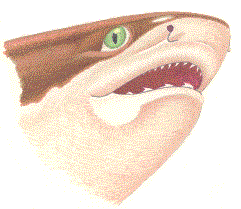|
|
|
 |
The Broadnose Sevengill Shark (Notorynchus cepedianus) |  |
|
Quick Facts |
||
| Identification The Broadnose sevengilled(BS) shark is immediately recognized because of its seven pairs of gill slits-most shark species have only five pairs. Its other unusual feature is its single dorsal fin. It has a wide head with a short blunt snout and small eyes. It is a large and powerful shark. Its silvery gray to brownish back and sides are speckled with numerous dark and white spots, while the under belly is white. Juvenile can be recognized with their white margins on their rear fins. | ||
 |
||
| The teeth of the BS Shark are very effective for cutting. The teeth of the upper jaw are jagged with cusps, except for a single middle tooth ; The teeth of the bottom jaw are comb shaped. This sharks diet includes other smaller sharks, rays, bony fishes, seals and carrion. It bites pieces of flesh caught by gill nets and hooks. | ||
 |
||
| Status and reproduction
The shark lives in temperate waters on continental shelves, at depths down to 450 foot (135 m) Although this species is wide spread it is not particularly abundant. It often comes close into shore but does not rest on the seabed. This explains why it is not commonly seen by divers. There are no records of this species attacking humans (except for divers in aquariums)but will scavenge on human corpses. They bear live young in shallow bays. Litter sizes vary, and can be as large as 82 pups. The pups are about 16-18" when born. |
||
 |
||